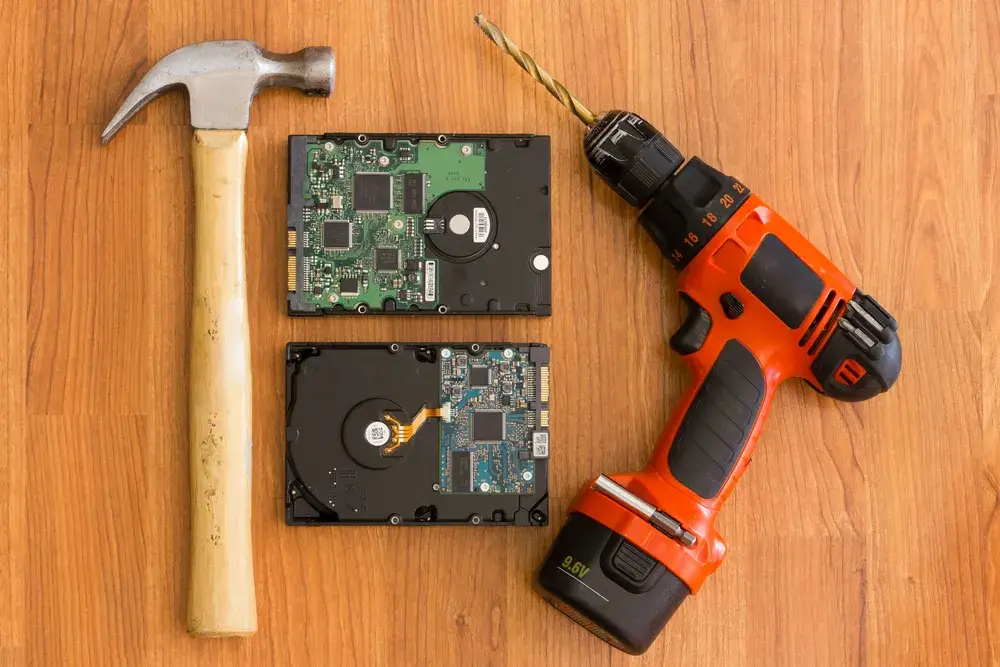Introduction
Secure Hard Drive Shredding Safeguarding sensitive data is more critical than ever. Whether you’re a business or an individual, failing to properly destroy your old hard drives can leave you vulnerable to data theft, legal consequences, and environmental harm. Secure hard drive shredding ensures that your data is irretrievably destroyed, giving you peace of mind and compliance with regulations.
In this guide, we’ll explore everything you need to know about hard drive shredding services, from understanding the process to selecting the right provider.
Understanding Hard Drive Shredding
Definition and Purpose
Hard drive shredding is the physical destruction of a hard drive to ensure the data stored on it is unrecoverable. Unlike formatting or wiping, which can sometimes leave data traces, shredding completely obliterates the storage medium.
Difference Between Shredding and Wiping
| Feature | Shredding | Wiping |
| Physical destruction | Yes | No |
| Data recovery risk | None | Possible |
| Speed | Fast | Varies |
| Best for | Compliance, security | Reuse, minimal risk scenarios |
Shredding is often the only acceptable option for certified hard drive destruction in sensitive industries.
Risks of Improper Hard Drive Disposal
Improper disposal can open the door to several threats:
- Data breaches that can lead to financial loss and damaged reputations
- Identity theft by criminals who extract personal details
- Legal consequences for violating data privacy laws like HIPAA or GDPR
Using professional data destruction services helps you avoid these risks altogether.
Benefits of Secure Hard Drive Shredding
Data Protection
Shredding ensures no residual data remains, eliminating risks associated with data recovery tools.
Regulatory Compliance
Many laws, such as HIPAA, require organisations to destroy data securely. Non-compliance can result in heavy fines.
Environmental Responsibility
Many eco-friendly data destruction companies recycle shredded materials, keeping e-waste out of landfills.
Methods of Hard Drive Destruction
Physical Shredding
The most secure and commonly used method. Hard drives are crushed or shredded into tiny particles.
Degaussing
Uses magnetic fields to scramble data. Effective but not always comprehensive and doesn’t render the drive physically unusable.
Data Wiping Software
Overwrites data with random characters. Suitable for low-risk data but not foolproof.
Choosing the Right Shredding Service
When looking for hard drive disposal services, consider the following:
Certifications to Look For
- NAID AAA Certification
- R2 Certification
These ensure the provider follows strict secure data destruction protocols.
On-Site vs Off-Site Shredding
- On-site hard drive shredding happens at your location, giving you full visibility.
- Off-site involves transporting drives to a facility, potentially increasing risk.
Cost Considerations
Mobile and on-site services might cost more but provide higher levels of assurance and compliance.
Regulatory Compliance and Legal Requirements
Various laws mandate secure destruction of data:
- HIPAA-compliant data destruction is required for medical records.
- GDPR enforces strict data privacy rules for EU citizens.
- Other regulations like FACTA, FERPA, and SOX may apply depending on your industry.
Using certified hard drive destruction services helps ensure full compliance.
Environmental Impact and Sustainability
Hard drive disposal isn’t just about data security; it’s also about the planet.
- E-waste concerns are growing, with millions of tonnes generated annually.
- Reputable services offer eco-friendly data destruction, recycling metals and plastics from shredded drives.
Look for providers who combine security with sustainability.
Best Practices for Data Destruction
Regular Data Audits
Perform audits to identify outdated hardware needing destruction.
Employee Training
Train staff on how to handle data and recognise when it’s time for destruction.
Documentation and Certificates
Always request a secure data destruction certificate to verify proper destruction procedures were followed.
Technological Advances in Shredding
Mobile Shredding Units
Modern mobile shredding services come to your door with high-powered shredders, offering immediate, visible destruction.
Automation in Data Destruction
AI and robotics are increasingly used to improve shredding efficiency and accuracy, minimising human error.
Case Studies
Real-World Data Breach
A major financial firm once discarded old drives without proper destruction. Hackers recovered client data, resulting in a multi-million dollar lawsuit.
Success Story
A healthcare provider partnered with an on-site hard drive shredding service. They avoided fines, gained customer trust, and earned industry certifications.
Conclusion
In a world where data breaches can cost millions, secure hard drive destruction is no longer optional; it’s essential. From on-site hard drive shredding to HIPAA-compliant data destruction, the right service provider can help you protect your data, comply with regulations, and support environmental sustainability. Don’t take chances with your digital footprint; choose certified, eco-friendly, and secure data destruction services today.
You can also read: The Ultimate Guide to Confidential Documents Shredding Compliance
FAQs
1: Why is physical shredding better than wiping a hard drive?
Shredding ensures total data destruction, while wiping can leave recoverable traces.
2: How do I know my data was securely destroyed?
Always ask for a secure data destruction certificate from your provider.
3: Can I shred hard drives myself?
DIY shredding can be risky and incomplete. Professional hard drive shredding services guarantee safety and compliance.
4: Is shredding eco-friendly?
Many companies offer eco-friendly data destruction, recycling drive components responsibly.
5: Do I need to be HIPAA compliant?
If you handle health data, yes. You need HIPAA-compliant data destruction methods.
6: What’s the cost of mobile shredding services?
Prices vary by volume and service type. Mobile shredding services offer convenience and security, often at a premium.



